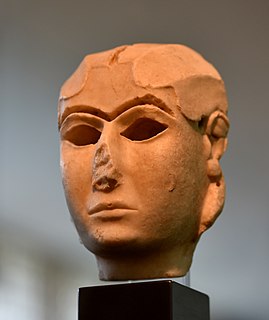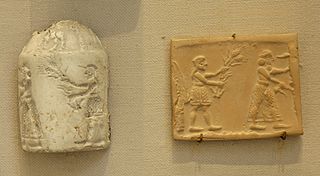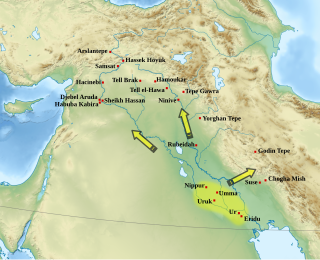 W
WUruk was an ancient city of Sumer situated east of the present bed of the Euphrates River on the dried-up ancient channel of the Euphrates 30 km (19 mi) east of modern Samawah, Al-Muthannā, Iraq.
 W
WThe art of Uruk encompasses the sculptures, seals, pottery, architecture, and other arts produced in Uruk, an ancient city in southern Mesopotamia that thrived during the Uruk period around 4200-3000 BCE. The city continued to develop into the Early Dynastic Period (Mesopotamia) around 2900-2350 BCE. Considered one of the first cities, the site of Uruk – modern-day Warka in Iraq – shows evidence of social stratification, institutionalized religion, a centralized administration, and what art historians would categorize as high art and architecture, the first in the long history of the art of Mesopotamia. Much of the art of Uruk shows a high technical skill and was often made using precious materials.
 W
WBirhurtura was a royal guard of Gilgamesh in Uruk. His military exploits are recorded in the Sumerian poem Gilgamesh and Aga, where Kish besieged Uruk to enslave the city into irrigation works.
 W
WA cylinder seal is a small round cylinder, typically about one inch in length, engraved with written characters or figurative scenes or both, used in ancient times to roll an impression onto a two-dimensional surface, generally wet clay. According to some sources, cylinder seals were invented around 3500 BC in the Near East, at the contemporary sites of Uruk in southern Mesopotamia and slightly later at Susa in south-western Iran during the Proto-Elamite period, and they follow the development of stamp seals in the Halaf culture or slightly earlier. They are linked to the invention of the latter's cuneiform writing on clay tablets. Other sources, however, date the earliest cylinder seals to a much earlier time, to the Late Neolithic period, hundreds of years before the invention of writing. They were used as an administrative tool, a form of signature, as well as jewelry and as magical amulets; later versions would employ notations with Mesopotamian cuneiform. In later periods, they were used to notarize or attest to multiple impressions of clay documents. Graves and other sites housing precious items such as gold, silver, beads, and gemstones often included one or two cylinder seals, as honorific grave goods.
 W
WE-sara (Cuneiform: E2 SAR.A 𒂍𒊬𒀀 "House of the Universe"), was the temple dedicated to Inanna in Uruk by Ur-Nammu (reigned c. 2112 BC – 2094 BC).
 W
WE-anna was an ancient Sumerian temple in Uruk. Considered "the residence of Inanna" and Anu, it is mentioned several times in the Epic of Gilgamesh, and elsewhere. The evolution of the gods to whom the temple was dedicated is the subject of scholarly study.
 W
WGilgamesh and Aga, sometimes referred to as incipit The envoys of Aga is an Old Babylonian poem written in Sumerian. The only one of the five poems of Gilgamesh that has no mythological aspects, it has been the subject of discussion since its publication in 1935 and later translation in 1949.
 W
WWilliam Kennett Loftus was a British geologist, naturalist, explorer and archaeological excavator. He discovered the ancient Sumerian city of Uruk in 1849.
 W
WThe Mask of Warka, also known as the Lady of Uruk, dating from 3100 BC, is one of the earliest representations of the human face. The carved marble female face is probably a depiction of Inanna. It is approximately 20 cm tall, and was probably incorporated into a larger wooden cult image, though it is only a presumption that a deity is represented. It is without parallels in the period. It is in the National Museum of Iraq, having been recovered undamaged after being looted when the United States invaded Iraq in 2003.
 W
WThe Temple of Gareus is located in Uruk in Iraq and probably dates to c. 110 AD. It dates back to the Parthian period, and is among the few surviving religious structures of Parthian date in Babylonia. The temple was made of fired bricks and consisted of a single room. The dimensions are 10.7 x 13.7 metres. The original height of the structure is unknown, but the surviving ruins of the structure are over eight metres high. The exterior was decorated with four half-columns with Ionic capitals and vaulted niches in between. In front of the temple's facade, there was a series of six columns. The structure was originally covered in plaster and decorated with a frieze depicting mythical creatures.
 W
WThe Uruk period existed from the protohistoric Chalcolithic to Early Bronze Age period in the history of Mesopotamia, after the Ubaid period and before the Jemdet Nasr period. Named after the Sumerian city of Uruk, this period saw the emergence of urban life in Mesopotamia and the Sumerian civilization. The late Uruk period saw the gradual emergence of the cuneiform script and corresponds to the Early Bronze Age; it has also been described as the "Protoliterate period".
 W
WThe Uruk Trough is an important Sumerian sculpture found at the site of Uruk, Iraq. It has been part of the British Museum's collection since 1928. Along with the Uruk Vase, the trough is considered to be one of the earliest surviving works of narrative relief sculpture from the Middle East, dating to 3300-3000 BC, during the Uruk period. Simple relief sculpture is known from much earlier periods, from the site of Göbekli Tepe, dating to circa 9000 BC.
 W
WThe Warka Vase or Uruk vase is a slim carved alabaster vessel found in the temple complex of the Sumerian goddess Inanna in the ruins of the ancient city of Uruk, located in the modern Al Muthanna Governorate, in southern Iraq. Like the Uruk Trough and the Narmer Palette from Egypt, it is one of the earliest surviving works of narrative relief sculpture, dated to c. 3200–3000 BC. Simple relief sculpture is also known from much earlier periods, from the site of Göbekli Tepe, dating to circa 9000 BC.